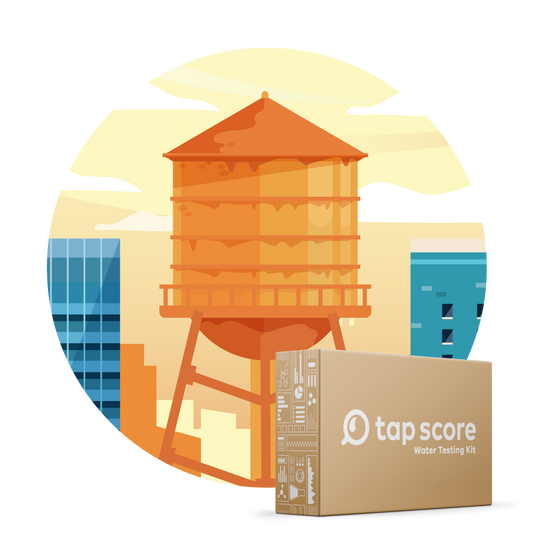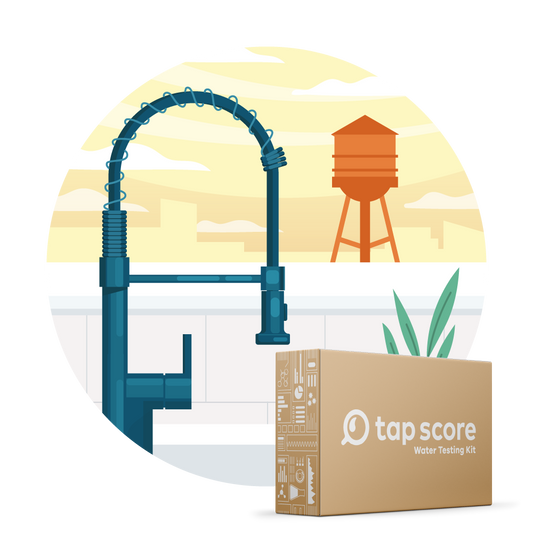
How Do I Test My Well Water in a Lab?
Our blog is written by real experts— not AI. Each guide is carefully reviewed and updated based on the latest research. Plus, with no affiliate links, you can count on unbiased insights you can trust.
If your water comes from a well, you probably know you need to test your well water regularly. But did you know that getting your well water tested in a certified laboratory is the best way to assess your water quality? It's also much easier than you think!
In this guide to well water testing, we cover the ins and outs of testing with a lab, including well sampling, what contaminants to test for, and how often you should test.
Table of Contents:
- What to Test for in Well Water
- Testing Your Well Water
- Interpreting Your Results
- How Often Should You Test Your Well Water?
- What’s the Takeaway?
What to Test for in Well Water
While there are many parameters (a.k.a. “analytes”) worth testing, the two most important well water contaminants to test for are:
- Coliform bacteria (like E. coli)
- Nitrate
Why Is Testing for Coliform Bacteria in Well Water Important?
A positive coliform test indicates that a pathway exists for potentially dangerous bacteria to contaminate your well. While not all coliform bacteria are harmful to human health, both harmless coliform and pathogenic coliform bacteria can come from the same sources. The presence of any coliform bacteria in your well water suggests there is a risk for illness.
How Does Coliform Bacteria Get into My Well?
Coliform bacteria may enter your well through broken septic systems, agricultural runoff, or poorly constructed/damaged wells which allow surface contaminants to enter the groundwater directly.

How Do I Test My Well Water for Bacteria?
If you want to target coliform in well water alone, you can use this Coliform and E. coli Test, which offers free overnight shipping:
A Quick Guide to Coliform Bacteria in Well Water
Why Is Testing for Nitrates in Well Water Important?
Testing your well water for nitrates is important because the vast majority of wells draw groundwater from aquifers in rural areas. Nitrates, which are found in animal manure and agricultural fertilizers, pass through soil and into groundwater supplies.
It is especially important to know if nitrates are in your water if there is an infant or someone pregnant in the home. Nitrate exposure in infants can cause blue baby syndrome (which prevents a baby’s blood from carrying oxygen throughout their body).
Are There Acceptable Levels of Nitrate in Well Water?
The Maximum Contaminant Level (MCL) for nitrates in drinking water is 10 PPM. This is also the health-based guideline for nitrate in drinking water. Anything above 10 PPM requires remediation.
How Do You Test Well Water for Nitrates?
While nitrate is included in Tap Score’s core well water testing kits, you can test your well water for nitrate with this high-resolution Nitrate Water Test:
What Other Contaminants Should I Test for in My Well Water?
Groundwater is very context specific. The list below is provisional and based primarily on the most common problems for wells nationwide. It's important to take this list as a starting point, and do the required research on your local area to know what's most important to test.
-
Initially
-
- Total coliform (including E. coli)
- Nitrate
- Arsenic
- Lead
- Manganese
- Fluoride
- Hardness
- pH
- TDS
- Any contaminants of local concern
-
Any relevant radionuclides
-
-
Annually
-
- Total coliform
- Nitrate
- pH
- TDS
- Any contaminants of local concern
-
-
Every 3-5 years
-
- Arsenic
- Lead
- Manganese
- Fluoride
- Hardness
- Any relevant radionuclides
-
Additional Parameters
As we mentioned above, pay close attention to the local context of your well. Contact your local health or environmental health department to discuss any contaminants of particular concern in your area.
Because wells draw from groundwater sources, heavy industry, industrial dumps, factory farming, and even military bases and airports in your geographical area can have big impacts on water quality—like hazardous chemicals leaching into your water supply.
If you live in an area where large, industrial agricultural activity takes place (e.g., “factory farms”) some additional contaminants of concern include:
- Pesticides (incl. insecticides, fungicides, and herbicides like glyphosate)
- Emerging contaminants (such as PFAS and PPCPs)
- Volatile organic compounds (VOCs) (less frequently)
- Petroleum products
Many of these contaminants cannot be seen, smelled, or tasted. Testing your water is the only way to find out if they’re in your water. Th extended core kit takes all of the crucial contaminants into account and adds the additional parameters mentioned above, including VOCs, SVOCs, and petroleum products.
How Does Agriculture Pollute Private Wells?
Ultimate Guide to Well Water Contaminants
How to Test Your Well Water
Collecting Your Sample
Remember to follow your test’s instructions carefully. The decisions you make during sampling can affect your results.
Choose WHERE to Sample
Most water testing kits are for a single location only. While there may be multiple bottles or vials, never put water from different sources in them. These different containers may test for different contaminants—in the chosen source—or serve as important back up samples.
The location you chose to collect your sample will influence what your results mean. For example, sampling directly from the well head will tell you about your well, whereas sampling from your kitchen faucet will tell you about the well PLUS your plumbing and faucet fixture.
If you have a water filter, you need to decide whether to test the filtered or unfiltered water. You can opt to buy two test kits and run a filter performance test, analyzing the water filter before and after installation.
Choose WHEN to Sample
The time of day you collect your water sample can also impact your results.
Certain plumbing-dependent metals like lead are most likely to show up after water has sat in the pipes overnight. For sampling bottles labeled for metals testing, you may choose to collect them first thing in the morning. This is generally called a “First Draw Sample.”
Dissolved gasses and other VOCs are more likely to diffuse out of the water if they sit in the plumbing for a long time. To capture whether your well water has VOCs (or radon) it’s often better to let the water run for a few minutes first.

Best Practices When Collecting Your Water Sample
- Do not rinse out the inside of the containers.
- Do not touch the inside of test vials or their lids.
- If possible, remove any aerators or other faucet attachments from the sample location.
- Collect all your samples from the same source (e.g. faucet or well-head).
- Use a low flow when drawing water.
- Close lids tightly! You don't want them to spill in transit.
You might receive separate packages from the lab. If you do, then take care to not mix up the contents of the packages. And even if your kit comes with two bottles, DO NOT collect samples from two different locations.

Returning Your Samples to the Lab
Remember to ship your samples as soon as possible after collecting your samples and avoid shipping on weekends. This is especially important when testing coliform bacteria in well water.
If you need to wait before dropping off or shipping, try to keep your samples refrigerated if indicated.
If you’re driving to the nearest certified environmental testing lab, it helps to know their receiving and closing hours. If you're testing with Tap Score, a pre-paid return label is included.
Don't forget to include your sample information card or chain of custody form with your sample! Being prepared helps you avoid any unforeseen issues.

Where Can I Get My Well Water Tested?
We’ve prepared a state-by-state guide to water testing labs where you can look into individual labs. Tap Score takes care of all of this, however, simplifying the selection process and handling all of the back end so you only have to think about collecting your sample. Free shipping both ways and award-winning customer service always included.
Tap Score Well Water Test Kits
Testing with is easy! All of our private well water testing kits include everything we’ve mentioned above—including free shipping back to the lab.
Which Well Water Test Kit Is Right for Me?
The Essential test kit is a great place to start if you’ve never tested your well water before. Test for coliform, nitrate, heavy metals, and general water chemistry parameters.
The Advanced test kit features everything above, as well as more specialized contaminants like VOCs and petroleum compounds.
The Extended well test is the recommended choice for new wells and/or new well owners. The widest scope available, the Extended Well test gives you the most comprehensive picture of your well water quality. It’s a good idea for all well owners to consider this test once every 5-10 years.
How Much Does it Cost to Test Well Water?
The cost of lab testing depends on the contaminants you test for. You'll find tests for as little as $60, but those might not give you a thorough analysis of how safe your water is to drink.
Laboratories use state of the art equipment to perform their analyses, and different techniques are required for different analytes. Both of these things factor into the price of a high quality water test.
Can You Get Your Well Water Tested for Free?
Your local or state health department may occasionally refer you to a certified environmental laboratory for a free test. However, most of these tests are very narrow in scope and might only include testing for analytes like coliform bacteria in well water and/or lead.
Some communities offer “Test Your Well” events where you can get a free well water screening.
We do not recommend "free" home water test kits offered by filtration companies—they often double as pushy sales tactics.
Do DIY Well Water Test Strips Work?
Test strips only work for quick readings of a few parameters (like free chlorine, pH, hardness). You can find cheap water test strips at just about any hardware store, but these at-home testing strips have major flaws you should be aware of before you buy.

- DIY strips and kits can be inaccurate.
- DIY tests do not have appropriate detection levels for most contaminants.
- Test strip results might be instant, but can be confusing to interpret.
- Test strips won’t include the same professional support you’d get from a certified laboratory.
Interpreting the Results of Your Well Water Test
Once the lab receives your water sample they'll analyze it according to the necessary testing methods. Turnaround times vary depending on the contaminants chosen for analysis.
Your results will show the concentrations of contaminants in your sample.
What Are the Units on My Well Water Results?
- Parts per million/PPM = mg/L of water (equal to putting ONE drop of water from an eyedropper into 10 gallons of water)
- Parts per billion/PPB = µg/L of water (equal to ONE drop of water in a 10,000-gallon swimming pool)
Is My Well Water Safe to Drink?
In an area without compromised groundwater, a well that is properly looked after should produce perfectly safe drinking water. Well water with any bacterial activity or nitrates and/or heavy metal concentrations above the EPA’s MCLs should be treated right away.
As a guide, the EPA sets legal limits for nearly 100 contaminants called Maximum Contaminant Levels (MCLs). They also provide Maximum Contaminant Level Goals (MCLGs)—thresholds based on health-based toxicology research. While these regulations have no impact on well water (because they are only enforceable at the public water system level), they are good indicators of health risks in your results.
Compare these limits to your own water report to get an idea of how well your water quality stacks up. Most labs will indicate if your sample exceeds an MCL, but you’ll want to evaluate your results against MCLGs to know if there is a health concern. Tap Score points out these comparisons for you.
Note: While some contaminants have an MCLG of zero, it is often not possible to completely eliminate them from your well water. This just means that health recommendations state the concentration of the contaminant should be as low as possible compared with the MCL.
If you tested your water twice and received different results, remember that the environment is constantly changing, and this means that tap water will vary with time. But it's also important to keep an eye on the sampling tips listed above so you don't compromise your sample.
Are There Other Concerns Around Well Water?
There are health standards beyond the EPA’s federal guidelines. Talk to your lab or Tap Score’s Support Team of water quality experts if you want more information about other kinds of health and aesthetic thresholds in your drinking water. A common and highly regarded source is California’s Office of Environmental Health Hazard Assessment’s Public Health Goals.
You or a family member might have health conditions or concerns that require you to treat water quality for contaminants NOT covered by the EPA. Consult your doctor and health experts to know what levels are safe for your family.
Also consider any pets you might have. Particularly small animals and aquarium fish are vulnerable to contaminants.
How Often Should I Test My Well Water?
The EPA suggests you test your private well at least once a year. Test more frequently if your well is shallow or if you have a surface water source (lake, river, stream, or reservoir) as these types of sources are more vulnerable to contamination.
Pay close attention to the local context of your well. Be sure to contact your local health or environmental health department to discuss any contaminants of particular concern in your area.
You should test…
- Initially for arsenic, lead, manganese, fluoride, hardness, any relevant radionuclides + annual list
- Annually for coliform bacteria, E. coli, nitrates, pH, TDS, and contaminants of local concern (e.g., certain pesticides, PFAS, etc.)
- Every 3-5 years for arsenic, lead, manganese, fluoride, hardness, and any relevant radionuclides
- Anytime your water has a change in taste, odor, or color
- Anytime there is a nearby natural disaster or chemical spill
- Anytime you install a new well or open your well to service it
- Anytime your well is tampered with or damaged
- After installing a water treatment device
- If a baby is expected in the home
What’s the Takeaway?
Always test your water before spending money on a water filtration or treatment system.
- You should test your well at least once a year, and anytime there is a change in taste, color, or odor, or a natural or industrial disaster in the area.
- Test your well water annually for coliform bacteria, nitrates, pH, TDS, and contaminants of local concern (e.g. PFAS, pesticides).
- Remember to follow your sampling instructions very carefully. The decisions you make during sampling can affect your result.
-
Tap Score’s Essential Well Test is a great place to start if you’ve never tested your water before.
Read More
▾A Quick Guide to Coliform Bacteria in Well Water
How Does Agriculture Pollute Private Wells?
Ultimate Guide to Well Water Contaminants
Water Testing Labs Near Me: State by State Guide
How To Interpret Water Testing Units
The Ultimate Tap Water Taste Guide







